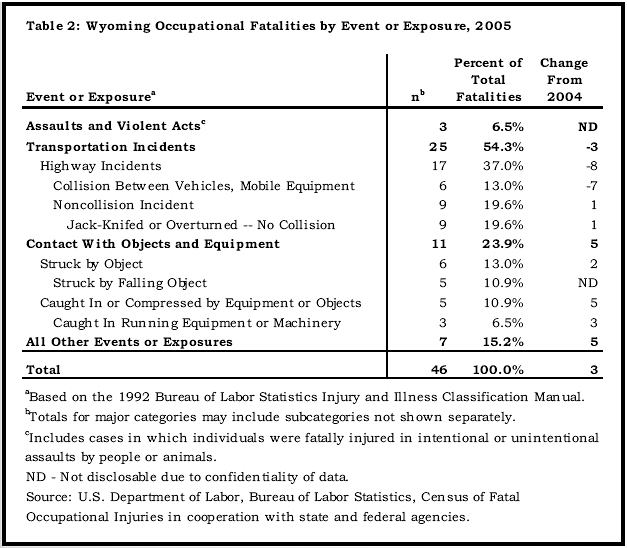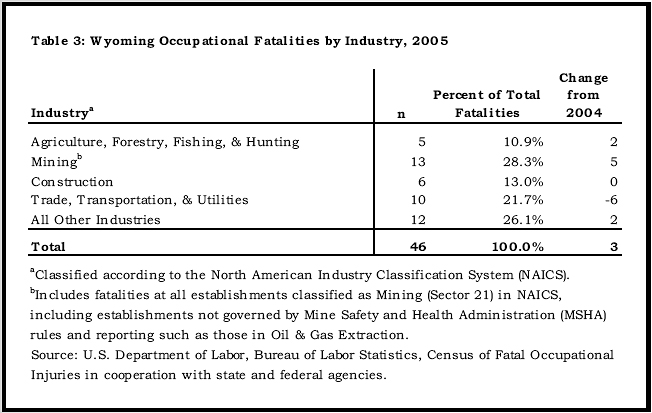© Copyright 2007 by the Wyoming Department of Employment, Research & Planning
Vol. 43 No. 10
Wyoming experienced the second year in a row in which a record number of work-related deaths occurred. Despite the relatively high total number of fatalities, highway accidents yielded their first decline in three years. Mining sustained the largest increase among industries. The rise in Mining deaths may be related to the employment growth that has been occurring in the industry since 2003. Although occupational fatalities are an important indicator of workplace safety, they represent only about 1% of total deaths each year in Wyoming.
During Wyoming’s current economic expansion (see related article), a corresponding increase in work-related deaths also occurred. Wyoming occupational fatalities reached a record high in 2005, with 46 work-related deaths recorded in the state (see Figure). It was the second year in a row in which a new high was reached. As a cause of work-related deaths, highway accidents declined for the first time in three years (see Table 1). Seventeen workers died on Wyoming’s roads and highways, a decline of eight from 2004. The decline in highway accident deaths from 2004 to 2005 was the largest since the Census of Fatal Occupational Injuries (CFOI) program began tracking work-related deaths in Wyoming in 1993. Additionally, 2005 was the first year since 2002 that highway accidents comprised less than half of all work-related deaths.
The decline was also reflected in the decrease in work-related deaths as a percent of total highway deaths from 2004 to 2005 (U.S. Department of Transportation, n.d.; see Table 1). In 2004, a total of 164 people died on Wyoming’s highways, of which 25 were work-related (15.2%). While total deaths on the state’s highways increased by 6 in 2005 to 170, work-related highway deaths fell by 8 to 17, or 10.0% of all highway deaths.
Two categories of events or exposures (i.e., how an accident occurred) accounted for a greater proportion of deaths in 2005 compared to 2004: contact with objects and equipment, and all other events or exposures. Both categories increased by five deaths (see Table 2). Additionally, there were three work-related deaths as a result of assaults and violent acts (includes cases in which individuals were fatally injured in intentional or unintentional assaults by people or animals). This is significant in that ordinarily there are too few incidents in this category to be reportable.
Among industries, Mining sustained the largest increase in work-related deaths in 2005, with an increase of five deaths over 2004 (see Table 3). The increase could be linked to employment growth in the industry since 2003 (U.S. Department of Labor, n.d.). Deaths in Agriculture, Forestry, Fishing, & Hunting rose by two over the previous year, while deaths in Trade, Transportation, & Utilities declined by six. The remaining industries experienced an increase of two deaths total.
Much of the reduction in deaths in Trade, Transportation, & Utilities is attributable to a decline in fatal highway accidents in the industry. In 2004, highway accidents claimed the lives of 14 workers in this industry. That number fell by half in 2005 to seven work-related deaths from highway accidents.
A total of 4,116 deaths occurred in 2003, of which 1.0% (43) were work-related. In 2004, workplace deaths in Wyoming accounted for 1.1% of the 3,941 total deaths (Wyoming Department of Administration & Information, n.d.). Although they are not inconsequential, it should be kept in mind that occupational fatalities represent a small share of total deaths in the state averaging approximately 1% per year.
Overall the number of occupational fatalities increased from 2004 to 2005. During the same period that occupational fatalities increased, employment in the state also grew (see Figure in related article), with much of the growth occurring in the Mining industry. The possibility exists that, rather than Wyoming’s workplaces being less safe, more workers were exposed to potential hazards. Additional research could confirm or refute this theory. As in all preceding years, deaths to men constituted the majority of fatalities (95.7%). However, there was a substantial decline in the number of highway accidents from 25 to 17. The fact that highway accidents accounted for a smaller percentage of total deaths in 2005 suggests that economic activity in industries such as Mining could be yielding additional accidents unrelated to travel.
References
U.S. Department of Labor, Bureau of Labor Statistics. (n.d.) Employment, hours, and earnings from the current employment statistics survey (state and metro area). Retrieved August 21, 2006, from http://stats.bls.gov/sae/home.htm
U.S. Department of Transportation, National Highway Traffic Safety Administration, National Center for Statistics and Analysis. (n.d.). Fatalities and fatality rates by state, 1994-2005. Retrieved September 15, 2006, from http://www-fars.nhtsa.dot.gov/ finalreport.cfm?title=States&stateid=0&year=2005&title2=Fatalities_and_Fatality_Rates
Wyoming Department of Administration & Information, Economic Analysis Division. (n.d.). Wyoming Births, Deaths, and Net Migration by County Of Residence: 1971 – 2004. Retrieved December 15, 2006, from http://eadiv.state.wy.us/pop/ BirthDeathMig.htm




Table of Contents | Labor Market Information | Wyoming
Job Network | Send Us Mail
Last modified on
by Phil Ellsworth.